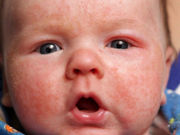Children have significantly higher induction of Th17-related cytokines and antimicrobials
MONDAY, Oct. 10, 2016 (HealthDay News) — Pediatric patients with atopic dermatitis (AD) have a different skin phenotype from that of adult patients, according to a study published online Sept. 23 in the Journal of Allergy and Clinical Immunology.
Hitokazu Esaki, M.D., from the Icahn University of Medicine at Mount Sinai in New York City, and colleagues characterized early pediatric AD skin phenotype using biopsies from 19 AD children aged younger than 5 years within six months of disease onset. Biopsies were assessed using immunohistochemistry and quantitative real-time polymerase chain reaction and compared with adult AD, psoriasis, and pediatric and adult controls.
The researchers found that, compared with adult AD, children showed comparable or greater epidermal hyperplasia and cellular infiltration in lesional skin. Strong activation of Th2 and Th22 axes, and some Th1 skewing were present, similar to adults. Compared with adults, children had significantly higher induction of Th17-related cytokines and antimicrobials, Th9/interleukin (IL)-9, IL-33, and innate markers (P < 0.02). Filaggrin expression was similar in AD and healthy children, and was down-regulated in adults with AD. Higher levels of inflammation and epidermal proliferation were seen in non-lesional pediatric AD skin.
“The skin phenotype of new-onset pediatric AD is substantially different from adult AD,” the authors write. “Although excess Th2 activation characterizes both, Th9 and Th17 are highly activated at disease initiation.”
Several authors disclosed financial ties to the pharmaceutical industry.
Full Text (subscription or payment may be required)
Copyright © 2016 HealthDay. All rights reserved.








